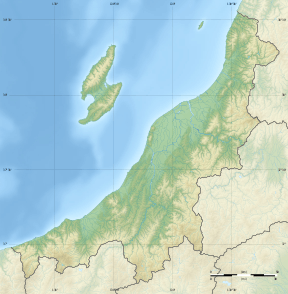Umataka-Sanjūinaba Site
Umataka-Sanjūinaba Site (馬高・三十稲場遺跡, Umataka-Sanjūinaba iseki) is an archaeological park containing the remnants of a large middle Jōmon period settlement located in Nagaoka, Niigata in the Hokuriku region of Japan. It is noted as the type site for a type of Jōmon period pottery which uses a flame-like motif. The site was designated a National Historic Site of Japan in 1979.[1]
馬高・三十稲場遺跡 | |
flame-motif pottery from the Umataka-Sanjūinaba Site | |
 Umataka-Sanjūinaba Site  Umataka-Sanjūinaba Site (Japan) | |
| Location | Nagaoka, Niigata, Japan |
|---|---|
| Region | Hokuriku region |
| Coordinates | 37°26′49″N 138°46′00″E |
| Type | settlement |
| History | |
| Founded | Jōmon period |
| Site notes | |
| Ownership | National Historic Site |
| Public access | Yes |
Overview
The site is located on a hill on the east bank the Shinano River, and was partially excavated by local amateur archaeologists in the Meiji period. It was subsequently excavated in the 1950s by Waseda University and the Nagaoka Board of Education, during which time the large extent of the settlement was realized. The settlement measured 150 meters east to west and 250 meters north to south. In addition to numerous examples of pottery, artifacts discovered included stone tools, objects made from jade, human-shaped figurines, and jewelry.
The Umataka portion of the site is the older portion, dating from approximately 5500 to 4500 years ago. The Sanjūinaba portion of the site dates from the late Jōmon period (approximately 4500 - 3200 years ago), and the style of pottery found in this location often had lids, and an intricate woven pattern. It was separated from the older Umataka site by a small lake and marsh. The Sanjūinaba portion of the site also had a pit where clay was mined.
Many of the artifacts found at the site are displayed at the Umetaka Jōmon Museum, which is located on site. One of the restored flame-motif pottery jars recovered from the site was designated a national Important Cultural Property of Japan in 1990, and the designation was expanded in 2002 to include a total of 126 items of pottery and 173 stone items during a collective designation.[2]
References
- "馬高・三十稲場遺跡" (in Japanese). Agency for Cultural Affairs.
- "新潟県馬高遺跡出土品" (in Japanese). Agency for Cultural Affairs.
External links
- Nagaoka city home page (in Japanese)
- Nagaoka city museum page(in Japanese)